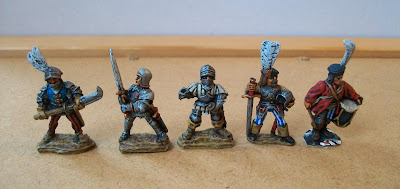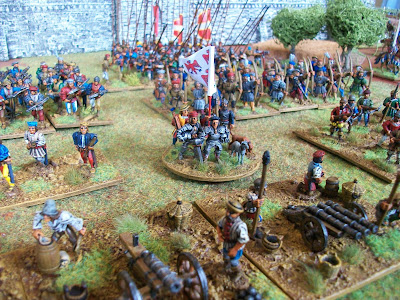Here are the Italian infantry I have been working on for a while now. I really enjoyed painting them, especially once the horror of painting the shields was over. The shields were made much easier by the use of the old Citadel transfers as described in a previous post. Some were painted free hand but the transfers have really helped to show a few more complex designs. Anyone who has read this blog for a while will know I loathe painting heraldry, or more correctly attempting to paint heraldry! Although these aren't heraldic shields, surviving examples show all kinds of motifs which are what I have attempted to reproduce here. I originally had 5 bases of these chaps and have completed another 7 to make quite a formidable group.
They are meant to represent Italian infantry for the 1490s into the 1500s, suitable for use from the French Invasion in 1494, through the French and Spanish campaigns in Naples, up until Agnadello in 1509, though at a pinch I would use them for a bit later. I have seen these troops described as "Rotularii", a kind of Italian assault infantry. They are a useful unit to have as Italian troops were, unsurprisingly, heavily involved in the Italian Wars. They could be found either fighting for the Italian states as mercenaries or militia, here they are shown in Milanese service, or as mercenaries in the service of France or Spain.
I have used Perry Miniatures with a dozen or so Assault Group figures mixed in as well. The pictures below, the first two of which I have shown before on this blog, give an idea of the kind of infantry they are meant to represent. Unfortunately for those of us trying to create miniature armies for this period, fashions at the end of the 15th century changed very quickly so while these may look great for 1490-1500, by 1515 Italian infantry, I would hazard a guess, showed more influence from Landsknecht style dress, though still retaining distinct differences that would have been recognisable at the time. Add to this the regional differences in Italian dress and it gets even more complicated.
 |
| Vittore Carpaccio, Arrival in Cologne, from the Legend of Saint Ursula, early 1490s |
 |
| Detail of the St Ursula Cycle, Martyrdom of the Pilgrims, early 1490s |
 |
| Infantry from Cronaca della Napoli aragonese c.1498 |
So in attempt to give a specifically Italian flavour to this unit I have added a few extra plumes of feathers to the headgear. The feathers I picked up from Simon at Je Lay Emprins,
http://je-lay-emprins.blogspot.co.uk/2013/08/plume-castings.html, a while ago and they have proven extremely useful for all sorts of small conversions. From the contemporary pictures above it is clear that the Italians were very keen on such plumage! I have also given a few of the polearmed troops bills as these seemed to be a characteristic weapon of the Italians, see the image above. The bill was not solely the preserve of the English Infantry. While probably a little out of date by 1500 I have included lots of Perry Miniatures with "mazzocchios", the fabric stuffed rolls that they wear around their Barbute helmets. Whether they would have been worn or not at this time they are excellent for adding to the Italian "feel" of these infantry.
Finally I don't understand how the polearmed troops could have used their polearms while also carrying those enormous shields! My guess is that a primary role of these troops was in assaulting enemy positions, similar to the Spanish Rodeleros. While the sword and buckler armed men would probably have retained their shields or bucklers for combat, perhaps those with polearms would have discarded their shields or shouldered them once the threat of projectiles had reduced and they had got to grips with the defenders.
In support of such a theory take a look at the below image, which is actually of Swiss infantry leading an assault in the early 1500s. They can clearly be seen using large shields to defend themselves as they scale the ladders, while some of the troops have them slung over their shoulders on straps. While Swiss not Italians in this picture, I would guess the Italian troops fought in a similar fashion. As a nod to this you will see that many of the miniatures armed with pole weapons have their shields over their backs and a strap added to hold them. The straps were just simple pieces of thread glued on before the undercoat was applied.
 |
| Swiss infantry assaulting a fortification using large shields |
 |
| Milanese Infantry for the early Italian Wars |
 |
| Italian Infantry |
 |
| Italian Infantry for the early Italian Wars |
 |
| A shot from behind to show the detail of the shields slung over the soldiers backs |
 |
| Another photo showing the infantry from the back |




















































